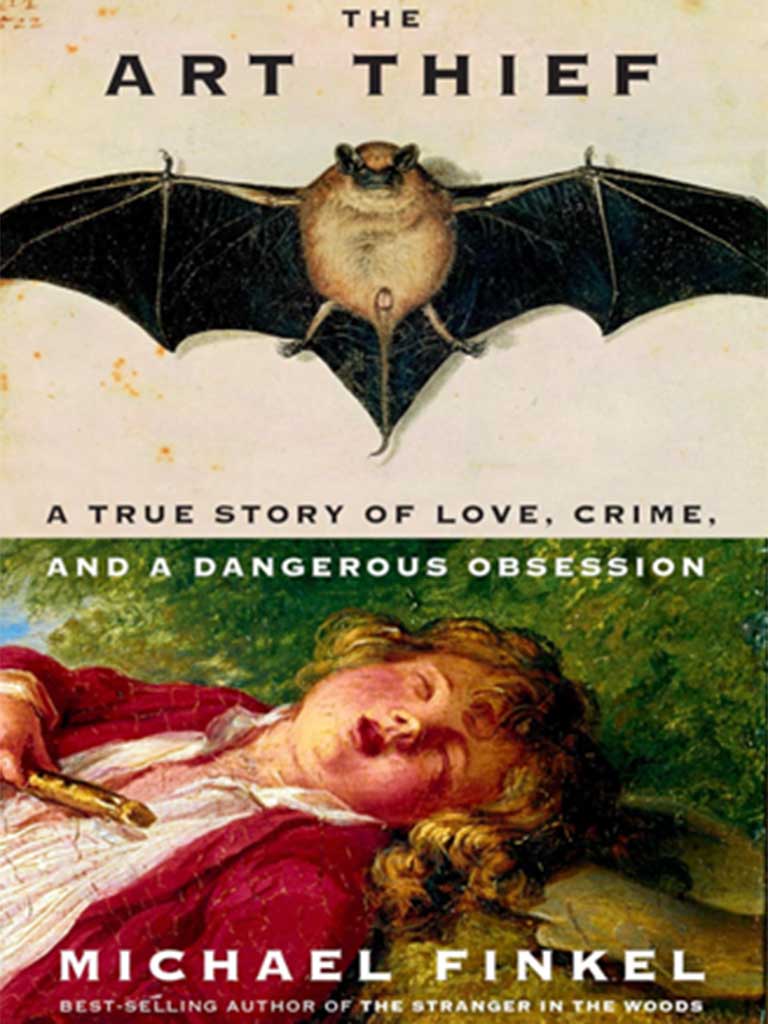Book Short

The Art Thief: A True Story of Love, Crime, and a Dangerous Obsession
Book Reviews by Stephanie Miller
A young man and his girlfriend walk into a museum in broad daylight and walk out with precious art and artifacts tucked into bags, under an overcoat, down a pant leg, or even just barely hidden under an arm. Equipped with a trusty and versatile Swiss army knife and knowledge of security operations from a stint working as a guard in a hometown museum, the man quietly and carefully opens glass cases, takes full size paintings off walls, and rearranges shelves to hide the gaps.
They get away with it for years. More than 200 museums are raided and the stolen collection was estimated at more than $1B. How is this possible?
“The Art Thief“ by Michael Finkel is the true story of French art thief Stéphane Bréitwieser and his audacious operation, exploring the whys, hows, and what fors of the world’s largest known raid on fine arts that took place in hundreds of museums, castles, and cathedrals in central Europe over half a decade.
It’s in the attic
One reason it was undetected for so long is the unusual motivation. The thief truly believed that he alone appreciated the works. He was convinced that keeping all the loot in a locked attic sanctuary where only he and his girlfriend could see it was a better place for these precious objects. Much better than in a musty museum where hardly anyone “got” them and few people saw them at all.
Stephane felt like a king. Until one day when it all came crashing down. In a fast-paced portrait of obsession and flawed genius, Finkel gives us a remarkable true-crime story of an insatiable hunger to possess beauty. Based on interviews with Stephane and many of the art crime inspectors who finally caught him, as well as newspaper coverage and trial archives, we get a glimpse into the rationale behind the thefts.
A self-proclaimed ‘art liberator’
After serving prison time, Stephane wrote a book, “Confessions of an Art Thief.” It didn’t sell as expected. Mostly because the author couldn’t stop himself from stealing again, getting caught just before the planned publish date.
Some of the most amazing parts are the interactions with museum staff, security officers, and even local police. None of whom suspected that the charming man and his quiet girlfriend had precious art hidden on their persons during the entire conversation. Once they even talked an officer out of giving them a parking ticket. All while an ancient sword was hidden down a pant leg, making Stephane stand and walk very stiffly.
After boldly stealing hundreds of items without ever breaking in or causing damage, he never sold a single item. He accumulated pieces he considered beautiful for his own enjoyment – seeing himself as an “art liberator.”
“The Art Thief” reads like a psychological thriller, while taking us on a tour of beautiful art and museums. It’s almost hard to believe this is a true story.
Micro Shorts
“The Frozen River“
By Ariel Lawhon
This historical fiction is inspired by the 18th Century life and diary of Martha Ballard. Ballard was a midwife in Hallowell, Maine, who defied the legal system by standing up for a rape victim. It all starts with a body found in the frozen Kennebec River. The deceased is one of the gentlemen accused of the rape.
In those days, women had no legal standing. In most rape cases the courts would fine, publicly humilate and imprison women for fornication. But the man would not be required to acknowledge his participation. Nor would he face any punishment. However, as a midwife and healer, Ballard could testify in these “courts.” And so, she risked her own livelihood and her family’s reputation to support a neighbor who had been brutally and repeatedly attacked.
Ballard is my kind of bold heroine. She refused to accept anything less than justice in a time when courts and society routinely silenced women’s voices. This novelization is a bit fanciful, but the framework of the actual story keeps it grounded and enjoyable.
“The Fox Wife“
By Yangsze Choo
In a mystical blend of love, second chances, and ancient myths, this wonderful saga follows the revenge mission of a fox named Snow – who can appear human – determined to eliminate the murderer of her daughter. Renowned for their beauty in human form, foxes have the reputation of luring men and women to their death using magical powers. However, Snow assures us that they are not (always) fearsome:
“Some people think foxes are similar to ghosts because we go around collecting qi (life force), but nothing could be further than the truth. We are living creatures, just like you, only usually better looking…“
This is a charming and delightful epic journey powered by a mother’s grief and based on fascinating Chinese folklore.
“The Secret Life of Sunflowers“
By Marta Molnar
We owe a debt of gratitude to Johanna Bonger, Vincent van Gogh’s sister-in-law, who inherited his paintings. They were all she had. And they weren’t worth anything. She was a 28-year-old widow with a baby in the 1800s. Without any means of supporting herself, she lives in Paris where she barely spoke the language. Yet she managed to introduce Vincent’s legacy to the world.
Molnar paces Joanna’s story of persistent and resilient love against a modern day woman in New York City whose business is failing as she grieves her artist grandmother’s death. I don’t love this kind of dual time period/narrator style, but I found the link between them pretty solid. Fight for what you believe in and give people a chance to build a community of support around you. The story of Johanna Bonger is the most interesting part, and makes up for some of the rather flat writing.
“The Berry Pickers“
By Amanda Peters
A family of itinerant First Nations people of Nova Scotia travel to Maine each year to pick berries. When their youngest daughter disappears, the family is tossed into a tempest of bad events. These events would shape the way they deal with the world, both as individuals and as a family.
Told in alternate voices of the kidnapped daughter and the brother who last saw her, the story unfolds in gentle waves – as each tries to deal with memory and guilt. Dealing with childhood trauma defines their relationships and confines them to limited choices.
The reader sees more than either. From our vantage, we watch them struggle to replace the comforting family life they knew together as children. This is a heartbreaking story of how one decision has so many repercussions throughout many lives.





